This month sees the following articles in Lab on a Chip that are in the top ten most accessed:
Commercialization of microfluidic point-of-care diagnostic devices
Curtis D. Chin, Vincent Linder and Samuel K. Sia
Lab Chip, 2012, Advance Article
DOI: 10.1039/C2LC21204H
Engineers are from PDMS-land, Biologists are from Polystyrenia
Erwin Berthier, Edmond W. K. Young and David Beebe
Lab Chip, 2012, 12, 1224-1237
DOI: 10.1039/C2LC20982A
Droplet microfluidics for high-throughput biological assays
Mira T. Guo, Assaf Rotem, John A. Heyman and David A. Weitz
Lab Chip, 2012, Advance Article
DOI: 10.1039/C2LC21147E
Standards for connecting microfluidic devices?
Henne van Heeren
Lab Chip, 2012, 12, 1022-1025
DOI: 10.1039/C2LC20937C
Sorting cells by size, shape and deformability
Jason P. Beech, Stefan H. Holm, Karl Adolfsson and Jonas O. Tegenfeldt
Lab Chip, 2012, 12, 1048-1051
DOI: 10.1039/C2LC21083E
Miniaturised technologies for the development of artificial lipid bilayer systems
Michele Zagnoni
Lab Chip, 2012, 12, 1026-1039
DOI: 10.1039/C2LC20991H
Cell sorting by deterministic cell rolling
Sungyoung Choi, Jeffrey M. Karp and Rohit Karnik
Lab Chip, 2012, 12, 1427-1430
DOI: 10.1039/C2LC21225K
A microfluidic device for high throughput bacterial biofilm studies
Jeongyun Kim, Manjunath Hegde, Sun Ho Kim, Thomas K. Wood and Arul Jayaraman
Lab Chip, 2012, 12, 1157-1163
DOI: 10.1039/C2LC20800H
Gene-Z: a device for point of care genetic testing using a smartphone
Robert D. Stedtfeld, Dieter M. Tourlousse, Gregoire Seyrig, Tiffany M. Stedtfeld, Maggie Kronlein, Scott Price, Farhan Ahmad, Erdogan Gulari, James M. Tiedje and Syed A. Hashsham
Lab Chip, 2012, 12, 1454-1462
DOI: 10.1039/C2LC21226A
A completely in vitro ultrahigh-throughput droplet-based microfluidic screening system for protein engineering and directed evolution
Ali Fallah-Araghi, Jean-Christophe Baret, Michael Ryckelynck and Andrew D. Griffiths
Lab Chip, 2012, 12, 882-891
DOI: 10.1039/C2LC21035E
Why not take a look at the articles today and blog your thoughts and comments below.
Fancy submitting an article to Lab on a Chip? Then why not submit to us today or alternatively email us your suggestions.
 The deadline is fast approaching for Lab on a Chip‘s Emerging Investigators themed issue, guested edited by Professors Amy Herr and Aaron Wheeler.
The deadline is fast approaching for Lab on a Chip‘s Emerging Investigators themed issue, guested edited by Professors Amy Herr and Aaron Wheeler.










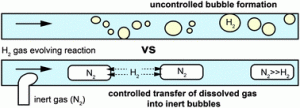




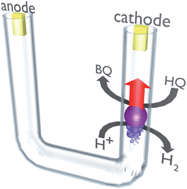 Gabriel Loget and Alexander Kuhn report for the first time the vertical propulsion of conducting beads in liquid filled capillaries by bipolar electrochemistry. Using a conical capillary a Yo-Yo type motion can be induced, making the concept then useful for cargo-lifting and of potential interest for microfluidic applications in lab-on-a-chip devices.
Gabriel Loget and Alexander Kuhn report for the first time the vertical propulsion of conducting beads in liquid filled capillaries by bipolar electrochemistry. Using a conical capillary a Yo-Yo type motion can be induced, making the concept then useful for cargo-lifting and of potential interest for microfluidic applications in lab-on-a-chip devices.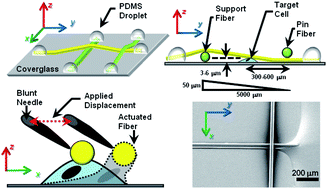 Philip LeDuc and colleagues from Carnegie Mellon University report the development of a minimal-profile, three-dimensional (MP3D) experimental microdevice which confines cells to a single focal plane, allowing observation with conventional epifluorescent microscopy.
Philip LeDuc and colleagues from Carnegie Mellon University report the development of a minimal-profile, three-dimensional (MP3D) experimental microdevice which confines cells to a single focal plane, allowing observation with conventional epifluorescent microscopy.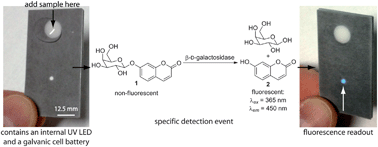
 icle
icle Siva Vanapalli and colleagues at Texas Tech University have developed a one-step passive strategy to create concentration gradients in static droplet arrays. Their recent Lab on a Chip article has been reported in PhysOrg.com, which discusses the implications of the technology for the future of drug testing.
Siva Vanapalli and colleagues at Texas Tech University have developed a one-step passive strategy to create concentration gradients in static droplet arrays. Their recent Lab on a Chip article has been reported in PhysOrg.com, which discusses the implications of the technology for the future of drug testing.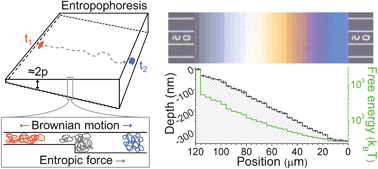 Samuel Stavis and colleagues at the National Institute of Standards and Technology (NIST) have developed a nanoscale fluidic channel shaped like a staircase, which can be used to control the direction of drift of a DNA molecule through a fluid. An article in Nanotechnology Now discusses how this ‘nanoslinky’ presents new possibilities for manipulating and measuring DNA.
Samuel Stavis and colleagues at the National Institute of Standards and Technology (NIST) have developed a nanoscale fluidic channel shaped like a staircase, which can be used to control the direction of drift of a DNA molecule through a fluid. An article in Nanotechnology Now discusses how this ‘nanoslinky’ presents new possibilities for manipulating and measuring DNA.